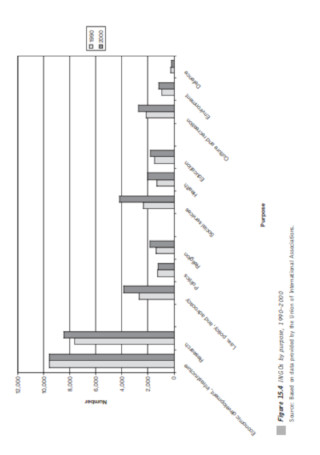Data is a powerful force. It can thrust a company to new heights. It can influence a national election. But its power lies in its presentation. When you consider it, data are…
continue reading
Non-Profit Organizational Charts
-

Organization Chart for a Non-Profit Template
download now -

Formal Non-Profit Organizational Chart Template
download now -

Traditional Nonprofit Organizational Structure Chart
download now -

Sample Charities Organizational Chart
download now -

Sample Charitable Organizational Chart Template
download now -

Non-profit Executive Committee Organizational Chart
download now -

Simple Non-Profi t Organizations Chart Template
download now -

Non-Profit Post-Closing Organizational Chart
download now -

Standard Non-Profit organization Chart Template
download now -

Formal Charity Organizational Chart
download now -

Non-Proft Organizational Chart Format
download now
Non-Profit Organizational Chart: What Is It?
A non-profit organizational chart, aka a hierarchy chart, is the best tool to provide a graphic representation of the staff roles, relationships between members, and the hierarchical ranks of a non-profit’s members. It works like a detailed family tree but in the business sense since the chart clarifies the levels and work positions of the non-profit staff. Also, these charts could be anything related to non-profit organizations, not just work positions. An example is to treat the organizational chart as a workflow chart; it lets you show the development workflow of non-profit activities chronologically.
As of April 2021, the estimated worth for each volunteer per hour in America is $28.54.
Why Is a Non-Profit Organizational Chart Important?
Non-profit organizational charts are significant because if an organization has over 50–100 members, can you actually memorize each member’s role or rank? You might err in assuming the non-profit president to be of the same rank as the assistant executive director. Hence, the chart is useful to trace who’s who and what each member’s work is. Why is a hierarchical chart necessary, you might ask? It inspires the whole staff to be a functional team. Someone of a lower rank can work harder and smarter to be promoted. And changing work positions or giving job promotions will bring growth and satisfaction to the members.
Also, don’t forget that non-profits are non-governmental operations. It should be managed carefully, especially when non-profits rely on donations or fundraising. And without an organizational chart, anyone could mishandle the budget. So besides understanding who owns the organization and what the members’ roles are, you can use non-profit organizational charts in tracking the accumulated funds, using an alternative activity flow chart template, presenting the non-profit work progress to the board, and so much more. It all depends on how you use the chart as long as it is related to non-profits.
What to Include in a Non-Profit Organizational Chart
To learn further what a non-profit organizational chart looks like, the key is to discover the standard requirements of this chart’s format, structure, and content. Although non-profit org charts differ according to your purpose in making it, standard examples would include the following elements:
What Are the Types of Non-Profit Organizational Charts?
There are numerous non-profit organizational charts out there. So it does not mean that there is only one way of creating the chart. In fact, you should get introduced to the specific types of non-profit org charts to know what your organization needs. And these are the common non-profit org chart examples:
Top-Down Organizational Chart
The top-down organizational chart, also called a vertical organizational chart, is self-explanatory. It means the details enlisted in the chart are presented in a vertical manner. This type is one of the easiest and most common styles as you only need to list the ones of the highest ranks at the top part of the chart while the members with lower ranks are found below. Hence, this is normally presented in portrait form.
Horizontal Organizational Chart
If top-down org charts are presented in portrait form, horizontal organizational charts are in landscape form. So you could mention the executive director on the far left side of the chart while the lowest-level member is on the far right side. Or perhaps, you present it in the other way wherein the low ranks are on the left while the manager would be on the right.
Functional Organizational Chart
The next example is the functional organizational chart, which is useful when the organization consists of various departments. In this case, bigger non-profit groups benefit from such charts. Commonly, the senior levels are found on top, the middle ground is for the leaders of every department, and the rest of the members are enlisted below.
Cross-Functional Organizational Chart
A hybrid form of a non-profit organizational chart is the cross-functional organizational chart. For small non-profits that still have plenty of departments, that means many individuals could belong to multiple departments. The same goes for the many reporting relationships. So in this case, you add more than just the top-down organization because you also add the linking of reporting relationships in a project. Hence, one person could have a variety of roles.
How to Create a Superb Non-Profit Organizational Chart
If you think making a non-profit organizational chart is a hassle, it is actually not the case. In fact, there are sample templates seen above this post. Those make it easier for you to make your non-profit’s official organizational chart. And for the best experience in creating non-profit organizational charts seamlessly, be sure to apply these steps:
Step 1: Review Your Non-Profit Organization
Before heading towards making an organizational chart, focus on reviewing the details about your non-profit first. A tip is to look for the official business contract, a list of the members’ records, and other essential elements worth adding to the chart later on. Without preparing the important documents, you might forget or commit mistakes along the way. And reviewing or having references will make the experience hassle-free in completing the chart.
Step 2: Use a Sample Non-Profit Organizational Chart Template
Instead of making charts in MS Excel, Google Sheets, and other examples, you don’t need to create them from scratch. In fact, this article has a list of every free non-profit organizational chart template you can use. Use sample non-profit organizational charts as a quick guide on how these charts are formatted. Also, you can modify the template however you want, thanks to the template’s customizable features. Optimize your chart now!
Step 3: Insert the Needed Elements to the Chart
You already learned about the names, roles, and other elements of what to include in a non-profit organizational chart earlier. So be sure to insert them into the chart one by one. Also, you can add more elements that fit your chart’s purpose. For example, you include specific shapes to present the development flow chart of your non-profit’s activities. Or perhaps, you make a detailed list highlighting a non-profit fact sheet. As long as the added elements align with your purpose, it will pay off.
Step 4: Set the Chart’s Format, Layout, or Structure
Expect to tweak and refine your chart’s format. That goes from the layout, structure, colors, fonts, etc. For example, you can be creative by inserting employee headshots in presenting every team member rather than writing their names. Also, use lines or arrows as a way of linking management relationships. The same goes for color-coding specific labels. As much as possible, the new format must improve the chart instead of making it worse.
Step 5: Be Wise on How Much Detail Your Chart Contains
Indeed, creating a detailed organizational chart is a splendid job. But maybe you have outdone it by inserting lots of unnecessary data or irrelevant content. In fact, charts don’t have to contain too many words or details. That explains why a chart is more visual. Know how to present your non-profit organization’s data in graphic style succinctly. Also, straightforward content is much more appreciated than lengthy or complicated ones.
Step 6: Always Do Fact-Checking and Update Your Chart
It should be common sense that a thorough assessment is standard to ensure that no errors are found in your non-profit organizational chart. Maybe there were errors towards linking relationships that the arrows pointed to the wrong people. Also, observe the accuracy in the spelling of names and other specifications. And after creating the chart, the job isn’t finished yet. Do not forget to update the chart regularly. Maybe there are new hires, some members resigned, or that other members have had their roles changed. Rectify the chart at all costs.
FAQs
When do you use non-profit organizational charts?
You can use a non-profit organizational chart for endless functions. And some of the most appropriate examples of when to use it are during an HR’s need to review the current work positions and levels of group members, a donor or sponsor meeting, the public’s introduction to the non-profit organization, and a new hire orientation to the management and team.
What are other tips to make a non-profit organizational chart?
Besides the steps mentioned before, you can follow these tips to ace the process of making non-profit organizational charts too:
- Use simple English or easy words; this will lessen the chances of making hard-to-follow charts.
- Don’t invalidate the efforts and achievements of the organization’s members.
- Be objective in labeling and ranking members; don’t take it personally.
- Collaborate with the whole team to discuss the chart’s details and for fact-checking purposes.
- Know how to arrange details so you won’t end up creating a hodge-podge of data.
What is the best structure for a non-profit organization?
The most highly recommended legal structure among non-profit organizations is to apply for federal-level tax exemptions. And you can actually make a business roadmap in processing it.
A non-profit organizational chart represents how well an organization’s team understands its roles, arranges its management, or decides its projects. So be sure you have an apparent and regularly updated chart prepared for your group. In fact, you have all the prerequisites needed from the knowledge you learned from this article and the tools, specifically the sample non-profit organizational chart templates. Download a template now!

